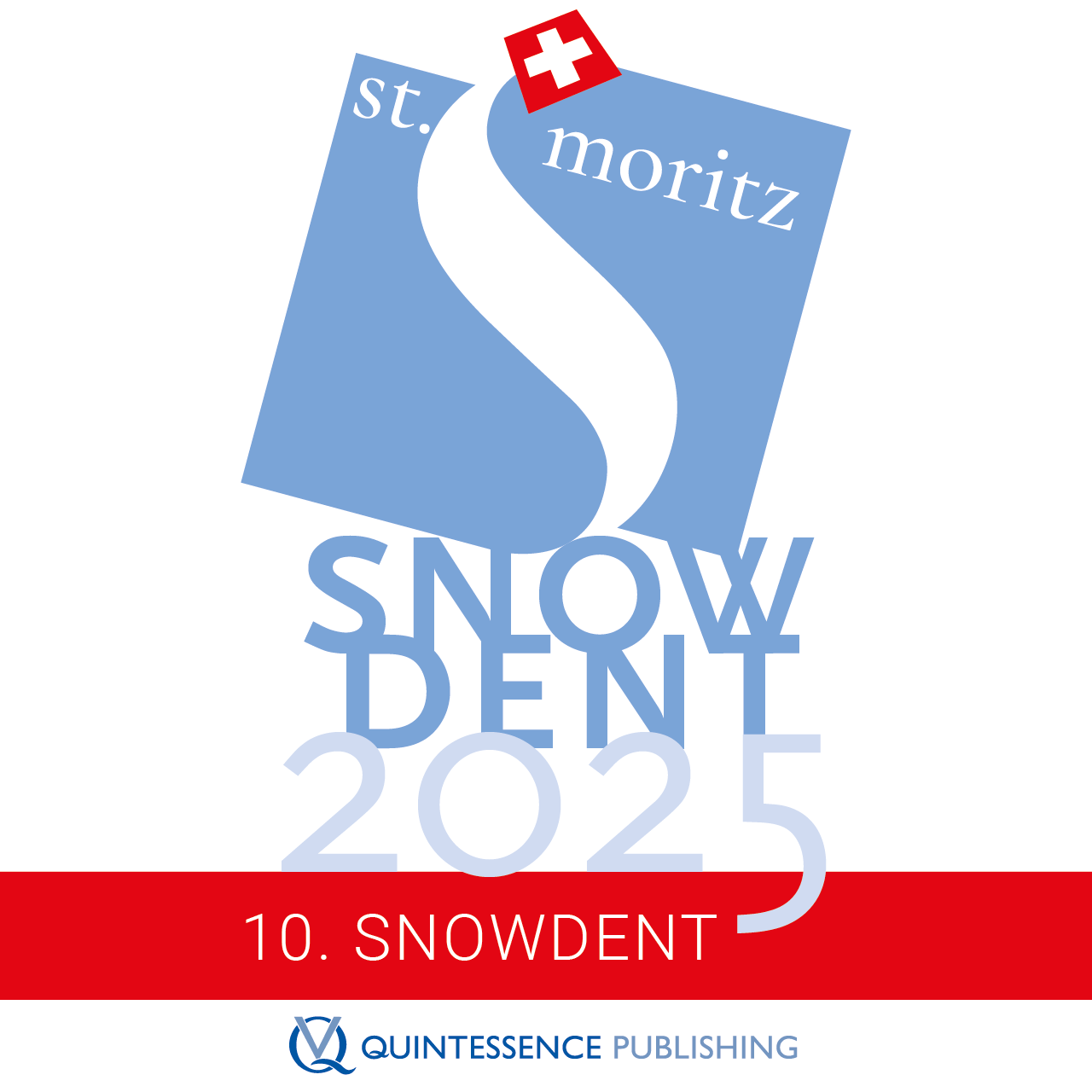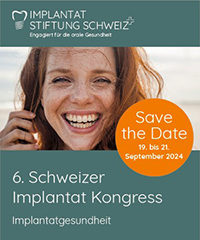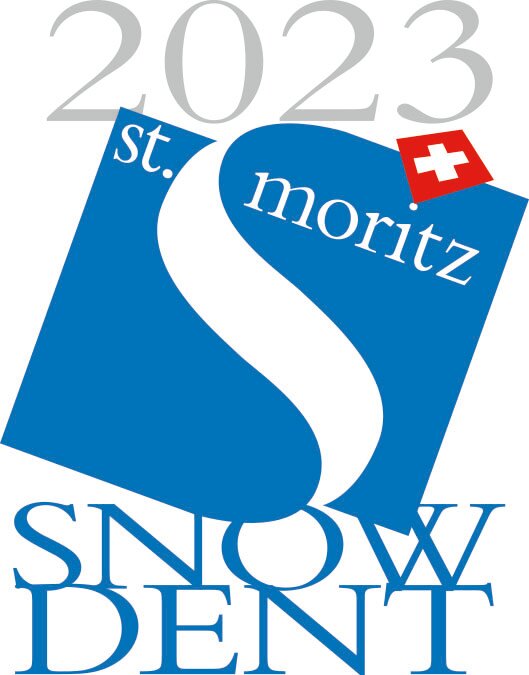International Journal of Periodontics & Restorative Dentistry, 4/2019
Online OnlyDOI: 10.11607/prd.4145, PubMed-ID: 31226187Seiten: e99-e110, Sprache: EnglischSancho-Puchades, Manuel / Alfaro, Federico Hernandez / Naenni, Nadja / Jung, Ronald / Hämmerle, Christoph / Schneider, DavidThe objective of this study was to compare patient-related outcomes of conventional protocols with computer-assisted implant planning and templateguided implant placement (CAIPP) protocols. Partially edentulous patients (N = 73) were assigned to either surgical planning based on two-dimensional radiographs and freehand implant placement (control; n = 26) or using threedimensional computer-tomography data and implant placement using a toothsupported surgical guide (test groups T1 [n = 24] and T2 [n = 23]). The two test groups differed from each other in digital data acquisition, software functionality, and the guide-manufacturing process. All surgeries were performed as openflap procedures. Patient-related outcome measures were evaluated using questionnaires. Statistical tests were performed to investigate differences between treatment groups. Before treatment, 53% of patients in the control group and 83% of patients in the test groups (T1: 88%, T2: 78%) were satisfied with their group allocation. In the control group, 37% of patients favored CAIPP technology, while only 11% in the test groups would have preferred a conventional procedure. After treatment, 50% of patients in the control and 86% in the test groups (T1: 76%, T2: 94%) were satisfied with their allocation. Twenty-one percent of controlgroup patients favored the CAIPP treatment, while 6% of the test-group patients would have preferred a conventional treatment. The quality-of-life parameters during and after surgery did not show significant differences between groups. More postoperative discomfort was reported after longer and more-complex surgeries including guided bone regeneration and surgeries with two surgical sites. Generally, patients preferred computer-based technologies. No differences in the intra- or postoperative discomfort were observed compared to control protocols. More-extensive surgical procedures negatively affected the intraand postoperative quality of life, irrespective of the treatment group allocation.
International Journal of Periodontics & Restorative Dentistry, 4/2019
Online OnlyDOI: 10.11607/prd.4147, PubMed-ID: 31226190Seiten: e111-e122, Sprache: EnglischSchneider, David / Sancho-Puchades, Manuel / Mir-Marí, Javier / Mühlemann, Sven / Jung, Ronald / Hämmerle, ChristophThe objective of this study was to compare the accuracy of conventional and computer-assisted implant planning and template-guided placement (CAIPP) protocols. Partially edentulous patients (N = 73) were randomly assigned to either a conventional implant planning and freehand placement protocol (control group, n = 26) or one of two different CAIPP protocols (stereolithographic guide [T1, n = 24] or 3D-printed guide [T2, n = 23]). The virtually planned and final implant positions were compared. Differences between the planned and the obtained implant position were evaluated as horizontal, vertical, and angular measurements. Descriptive statistics were calculated for overall deviation values and their fragmented mesiodistal and bucco-oral vectors at each evaluation plane. To study overall accuracy differences between study groups, analysis of variance (ANOVA) was used with Bonferroni post hoc test (Scheffé method). Possible confounding variables were analyzed using multiple linear regression with respect to treatment group. The mesiodistal or bucco-oral distribution of the positioning errors was evaluated with chi-square test. A multiple linear logistic regression was used to identify confounding variables. Inaccuracy at the level of the occlusal plane of the restoration averaged 0.65 ± 0.26 mm in the control group, 0.59 ± 0.4 mm in T1, and 0.76 ± 0.5 mm in T2. At the implant shoulder level, the inaccuracy amounted to 1.25 ± 0.62 mm, 0.97 ± 0.36 mm, and 0.72 ± 0.31 mm in the control group, T1, and T2, respectively. At the implant apex, mean deviations of 2.32 ± 1.24 mm were recorded in the control group, 0.97 ± 0.57 mm in T1, and 1.08 ± 0.57 mm in T2. Mean discrepancies in vertical direction measured 0.28 ± 1.01 mm (control), 0.2 ± 0.65 mm (T1), and -0.1 mm ± 1.0 mm (T2). Angular deviations of 7.36 ± 3.36 degrees (control), 4.23 ± 2.68 degrees (T1), and 3.13 ± 2.12 degrees (T2) were measured. Statistically significant differences were observed between the conventional and the two CAIPP groups for overall deviations at implant shoulder, apex, and implant angulation. CAIPP protocols seemed to provide a higher accuracy and precision compared to conventional freehand protocols. Still, the amount of inaccuracy using guides demands a safety margin. Moreover, intrasurgical verification during drilling and the implant placement procedure should be performed, including clinical parameters that may not be available from cone beam computed tomography data during the planning phase.
International Journal of Periodontics & Restorative Dentistry, 3/2019
Online OnlyDOI: 10.11607/prd.4146, PubMed-ID: 30986285Seiten: e71-e82, Sprache: EnglischSchneider, David / Sancho-Puchades, Manuel / Schober, Florian / Thoma, Daniel / Hämmerle, Christoph / Jung, RonaldThis paper performed time and cost analyses and compared conventional vs computer-assisted implant planning and placement (CAIPP) protocols when placing single implants in partially edentulous patients. Partially edentulous patients were randomly allocated to one of three treatment groups: preoperative planning based on a conventional two-dimensional radiograph and free-hand implant placement (control [C], n = 26) or computer-assisted implant planning based on three-dimensional (3D) computer-tomography (test group 1 [T1], n = 24; test group 2 [T2], n = 23). A surgical guide was produced by stereolithography in T1 and by 3D printing in T2. In all patients, open-flap implant placement procedures were performed. Time and costs derived from each working step were recorded for each treatment protocol. Descriptive and analytic statistics were used to display the data and uncover differences between treatment groups. Overall office time was similar in all groups (C = 63.8 min; T1 = 77.2 min; T2 = 81.7 min). CAIPP and conventional protocols required similar times to perform the preoperative diagnosis, radiographic exam, and implant surgery. CAIPP protocols required longer surgical planning and template-production times. Overall economic costs were 31% (T1) to 20% (T2) higher for the CAIPP protocols due to the radiographic investigation and the surgical template production (C = Swiss francs [CHF] 1,567; T1 = CHF 2,268; T2 = CHF 1,946). In the present indication and methodologic set-up, computer-assisted protocols did not show an advantage over conventional protocols in terms of time or financial savings. The temporal and financial expenses should be put into perspective to potential benefits.
International Journal of Periodontics & Restorative Dentistry, 7/2018
SupplementSeiten: 49-57e, Sprache: EnglischSchneider, David / Sancho-Puchades, Manuel / Benic, Goran I. / Hämmerle, Christoph H. F. / Jung, Ronald E.The objectives of this study were to compare conventional and computer-assisted implant planning and placement (CAIPP) protocols regarding surgical planning predictability, intraoperative complications, and patient-centered outcomes. Partially edentulous patients (N = 73) were randomly allocated to one of three treatment groups: control (C, n = 26), with preoperative planning based on conventional radiography and freehand implant placement; and test 1 (T1, n = 24) and test 2 (T2, n = 23), with two different CAIPP protocols. The clinicians' predictions of the bony morphology, materials needed for surgery, and surgery duration were matched with intrasurgical findings using kappa tests. Complications or deviations from the surgical or prosthetic protocol were recorded. Descriptive statistics were used to study the sample sorted out by treatment group. Differences between groups were evaluated with chi-square test for qualitative variables and with nonparametric Kruskal-Wallis test for quantitative continuous variables. For post-hoc tests, the Bonferroni corrected (P .016 = .05/3) Mann-Whitney test was used. CAIPP protocols showed better diagnostic potential than conventional protocols for the bone topography, need for simultaneous GBR procedures, membrane selection, and implant length predictions. The rate of surgical protocol deviations was similar in all groups, but their nature differed. Conventional protocols showed fewer splint-related incidences. Implant bed preparation and insertion could not be fully completed using the surgical splint in 3.8% of patients in C (1/26), 45.8% in T1 (11/24), and 47.8% in T2 (11/23). Deviation from the initial prosthetic plan was necessary in one case (T2; 4.4%). No biologic or technical complications were observed. CAIPP protocols showed a higher diagnostic potential than conventional protocols. A high incidence of intraoperative surgical protocol modifications to adjust suboptimal implant placements was reported for every group. Therefore, strict intraoperative implant position monitoring is mandatory for both treatment protocols.
International Poster Journal of Dentistry and Oral Medicine, 1/2017
Poster 1114, Sprache: EnglischNaenni, Nadja / Schneider, David / Hämmerle, Christoph H. F. / Jung, Ronald E. / Hüsler, Jürg / Thoma, Daniel S.The aim of the present study was to test whether or not one of two GBR membranes is superior to the other in terms of: i) vertical defect resolution and bucco-oral width of regenerated bone at the implant shoulder after 6 months, ii) postoperative complications and during the 6-month follow-up and, iii) histologically assessed newly formed bone at 6 months. In 27 patients, 27 implants were placed in single-tooth gaps. The augmented dehiscence defects were then randomly covered with either a resorbable membrane or a titanium-reinforced non-resorbable membrane. Both treatment modalities were clinically and radiologically effective in regenerating bone on the buccal aspect of single tooth dental implants showing dehiscence- type defects. Despite a higher initial horizontal thickness, sites with the resorbable membrane experienced a significantly higher reduction in bone thickness after 6 months compared to the non- resorbable membrane.
Schlagwörter: dental implants, guided bone regeneration, membrane, CBCT
Implantologie, 4/2014
Seiten: 341-351, Sprache: DeutschAnnen, Beat Martin / Schneider, David / Schmidlin, Patrick RogerEine Fallserie mit volumetrischer AuswertungZiel: Untersuchung des Kieferkammremodelings auf Weichgewebeniveau bei Anwendung einer neuen Kammerhaltungstechnik mit einem Kollagenkegel mit integrierter Membran.
Material und Methoden: Bei 10 konsekutiven Patienten, welche einer Prämolarenextraktion bedurften, wurde eine Kammerhaltungstherapie mit einem Kollagenkegel mit integrierter Membran durchgeführt. Studienmodelle wurden vor der Extraktion und nach 3 Monaten hergestellt, digitalisiert und die Volumenänderungen nach optischer Überlagerung mittels Software vermessen. Die Resultate wurden statistisch ausgewertet und mit der aktuell verfügbaren Literatur verglichen.
Resultate: Insgesamt war der Heilungsverlauf, bis auf eine Ausnahme, unauffällig. Aufgrund einer alveolären Infektion musste der Kollagenkegel bei diesem Fall wieder entfernt werden. Nach 3 Monaten zeigte sich bei allen Fällen ein horizontaler Konturverlust von durchschnittlich -1,47 mm (SD ± 0,78).
Schlussfolgerung: Anhand der Resultate der optischen Modellvermessung konnte der Kollagenkegel mit integrierter Membran eine Kammresorption nicht vollständig verhindern. Im Vergleich mit Daten aus anderen Studien scheint aber gegenüber der Spontanheilung ein leicht reduziertes Remodelling stattzufinden, was vorwiegend auf den Verschluss der Alveole zur Mundhöhle zurückzuführen sein könnte.
Schlagwörter: Kollagenkegel, Extraktionsalveole, alveoläre Kammerhaltung, klinische Fallserie, volumetrische Studie
The International Journal of Oral & Maxillofacial Implants, 7/2009
SupplementPubMed-ID: 19885437Seiten: 92-109, Sprache: EnglischJung, Ronald E. / Schneider, David / Ganeles, Jeffrey / Wismeijer, Daniel / Zwahlen, Marcel / Hämmerle, Christoph Hans Franz / Tahmaseb, AliPurpose: To assess the literature on accuracy and clinical performance of computer technology applications in surgical implant dentistry.
Materials and Methods: Electronic and manual literature searches were conducted to collect information about (1) the accuracy and (2) clinical performance of computer-assisted implant systems. Meta-regression analysis was performed for summarizing the accuracy studies. Failure/complication rates were analyzed using random-effects Poisson regression models to obtain summary estimates of 12-month proportions.
Results: Twenty-nine different image guidance systems were included. From 2,827 articles, 13 clinical and 19 accuracy studies were included in this systematic review. The meta-analysis of the accuracy (19 clinical and preclinical studies) revealed a total mean error of 0.74 mm (maximum of 4.5 mm) at the entry point in the bone and 0.85 mm at the apex (maximum of 7.1 mm). For the 5 included clinical studies (total of 506 implants) using computer-assisted implant dentistry, the mean failure rate was 3.36% (0% to 8.45%) after an observation period of at least 12 months. In 4.6% of the treated cases, intraoperative complications were reported; these included limited interocclusal distances to perform guided implant placement, limited primary implant stability, or need for additional grafting procedures.
Conclusion: Differing levels and quantity of evidence were available for computer-assisted implant placement, revealing high implant survival rates after only 12 months of observation in different indications and a reasonable level of accuracy. However, future long-term clinical data are necessary to identify clinical indications and to justify additional radiation doses, effort, and costs associated with computer-assisted implant surgery.
Schlagwörter: computer-assisted implant dentistry, dental implants, navigation
The International Journal of Prosthodontics, 1/2008
PubMed-ID: 18350948Seiten: 53-59, Sprache: EnglischOtto, Tobias / Schneider, DavidPurpose: The objective of this follow-up study was to examine the performance of Cerec inlays and onlays, all of which were placed by the same clinician, in terms of clinical quality over a functional period of 15 years.
Materials and Methods: Of 200 Cerec inlays and onlays placed consecutively in a private practice by one of the authors (TO) between 1989 and early 1991, 187 were closely monitored over a period of 15 years. All ceramic inlays and onlays had been placed chairside using the Cerec 1 method and had been luted with a bonding composite. Up to 17 years after their placement, a follow-up assessment was conducted, and the restorations were classified using modified United States Public Health Service criteria.
Results: According to Kaplan-Meier analysis, the success rate of Cerec inlays and onlays was 88.7% after 17 years. A total of 21 failures (11%) were found in 17 patients. Of these failures, 76% were attributed to ceramic fractures (62%) or tooth fractures (14%). The reasons for the remaining failures were caries (19%) and endodontic problems (5%). Restorations of premolars presented a lower failure risk than those of molars.
Conclusion: The survival rate probability of 88.7% after up to 17 years of clinical service for Cerec computer-aided design/computer-assisted machining restorations made of Vita Mk I feldspathic ceramic is regarded as a very respectable clinical outcome.







